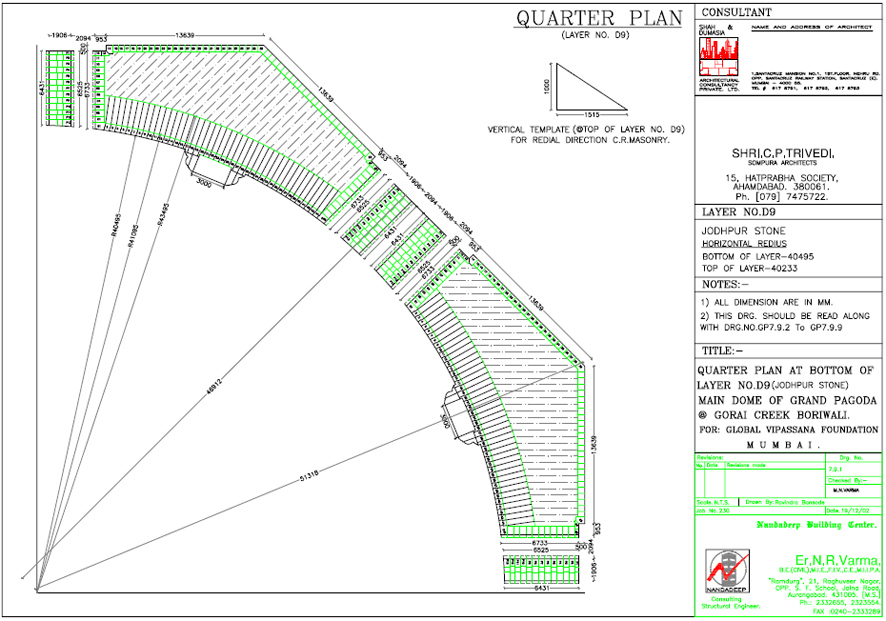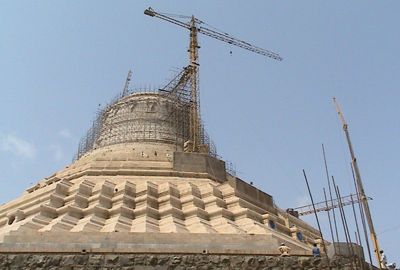GLOBAL VIPASSANA PAGODA
THE LARGEST DOME IN THE WORLD: 85.15 M DIAMETER
The information presented hereafter was graciously provided by Eng. Mahesh Varma from Nandadeep Building Center.
The Global Vipassana Pagoda is a notable monument in Mumbai, India which serves for peace and harmony. The monument was inaugurated by Pratibha Patil, President of India on 8th February 2009. It is located in the North of Mumbai on a peninsula between Gorai Creek and the Arabian Sea. The Global Vipassana Pagoda was built out of gratitude to the Buddha, his teaching and the community of monks practicing his teaching.
Its traditional Burmese design is an expression of gratitude towards the country of Myanmar for preserving the practice of Vipassana. The shape of the pagoda is a copy of the Shwedagon Pagoda in Yangon, Myanmar. But the Shwedagon Pagoda is made of solid masonry whereas the Global Vipassana Pagoda is hollow with an exceptional dome to welcome meditators. It was built combining ancient Indian and modern technology to ensure it lasting for a thousand years.
The Global Vipassana Pagoda was designed by Nandadeep Building Center and the genius behind the Dome of the Global Pagoda was Eng. Mahesh Varma and his team: Shri N. R. Varma as a Consulting Engineer, Shri Parvezji as an Architect, Shri R. S. Jangid as a Proof Consultant and late Shri Chandubhai as a Sompura Consultant (Stone Consultant). Manesh Varma developed a tool using the Finite Elements Method to study the stability of the domed structure of the Global Pagoda. His initial inspiration derived from the graphic method developed by the Auroville Earth Institute to design vaults and domes, but his special software represents a tremendous advancement in the methods available for studying dome stability.
1. Purpose of the Global Vipassana Pagoda


The inside of the pagoda is hollow with a very large meditation hall of ~5,700 m2 (~61,000 ft2). The massive inner dome seats around 8000 people enabling them to practice the non-sectarian Vipassana meditation as taught by Mr S.N. Goenka and now being practiced in over 100 countries. An inaugural one-day meditation course was held at the pagoda on 21st December 2008, with Mr S.N. Goenka in attendance as the teacher.
Among the aims of the pagoda complex are to express gratitude to Gautama Buddha for dispensing what followers believe is a universal teaching for the eradication of suffering, to educate the public about the life and teaching of the Buddha, and to provide a place for the practice of meditation. Ten-day Vipassana meditation courses are held free of charge at the meditation centre that is part of the Global Vipassana Pagoda complex
2. Structural Design
2.1 General data
Total height of the Pagoda: 89.93 m
Clear span of the main dome: 85.15 m
Clear height of the main dome: 26.27 m
Total Masonry stone: 76,500 m3 (192,000 tons)

The centre of the Global Vipassana Pagoda contains the world’s largest stone dome built free spanning (without support).
The internal diameter of the main dome is 85.15 m, which is twice the size of the previously largest hollow stone monument in the world, the dome of St. Pierre of Rome which has 41.47 m diameter. The dome is surrounded by octagonal masonry.
The external diameter of the largest section of the octagonal Pagoda is 102.62 m and the shortest section is 93.82 m. The clear height of the dome is approximately 26.27 metres. The height of the building is 89.93 meters.
The pagoda consists of a main segmental dome of 85.15 m. A catenary dome sits above the main dome and is surrounded by an auxiliary dome. The top of the structure is crowned by a conical dome.


2.2 Stability study of the domes


3. Construction Process
Building the first dome
The planning phase for the construction of the Global Vipassana Pagoda began in 1997, while the actual construction phase started in 2000.

Starting foundations of the first dome


Stone dressing for the first dome




Building the first dome without centring
The dome was built free spanning (without centring): the rings of masonry were self-supporting, as blocks were interlocking.


















Completion of the main dome
The first and main dome was completed in October 2006 and bone relics of Gautama Buddha were enshrined in the central keystone of the dome on 29th October 2006, making it the world’s largest structure containing relics of the Buddha. The relics were originally found in the stupa at Sanchi. They had been donated by the Mahabodhi Society of India and the prime minister of Sri Lanka to be kept at the Global Vipassana Pagoda.


Building the auxiliary dome, second catenary and third conical dome
The auxiliary dome was started when the main dome was about halfway constructed. The second catenary dome started once the first dome was near completion. The last conical dome started only once the catenary dome was completed. The third and last dome was structurally completed on the 21st November 2008.



















Mr Satprem Maïni had the great opportunity to visit these domes. This area is normally inaccessible and closed to the public.




Vipassana Global Pagoda in December 2010


For the projects and teachings going on in the Vipassana Global Pagoda today, please visit the following website: http://www.globalpagoda.org/.
4. Team in charge of the structural design: Nandadeep Building Center
Mr. N.R Varma (Consulting Civil and Structural Engineer) has started with consultancy in 1984 after resigning from Irrigation Department from the post of executive engineer. Later with inclusion of his son Mr. Prashant Varma (Structural Engineer), Mr. Purushottam Varma (Architect), Mr. Mahesh Varma (Structural Engineer) and his daughter in law Mrs. Pallavi Varma (Architect) it took the shape of “Varma Group of consultancy”.
In 1997, Varma Group has ventured in Nandadeep Precast Prestress Concrete Private Limited for manufacturing the precast housing components. The products designed by Nandadeep were all light weight and thus need no machines for handling over the site; this was different approach as compared to European heavy Precast. These light weight products have eventually brought the concept of Precast (Readymade housing) in reach of the common man specifically in Marathwada region.
In 1999, HUDCO and Govt. of India have assisted the project for cost effective housing technology development through precast and other technology under NPPCPL. This supported venture was named as Nandadeep Building Center; and the scope of work was manufacturing of precast components, training, consultancy and research.

They have made major contributions to masonry research, consultancy and execution.
They have been consultant to PSC (Prestress Spun Concrete) poles for transmission line towers to Beton Concrete Private Limited and KEC international, wherein they implemented many international projects for Ethiopia, Oman, Afghanistan, and other countries.
They have experience in designing and detailing for large scale precast housing projects as per international codes of practice.
They have given architectural and structural consultancy to numerous industry, residence and commercial structures in last 25 years (1984-till date).
Recently they have started with InfoTech wing; working on structural software and management software (NCMS) for architects /civil engineers.
In these last 10 years of establishment of Nandadeep Building Centre, they have achieved all the proposed goals to some extend and will be looking forward to serve the society in more effective manner. Nandadeep under precast manufacturing unit have developed many precast products include slab beam systems, steps, spacers, door frames and compound wall. More info in the Nandadeep website.
Contact US
- Address:Auroville Earth Institute, Auroshilpam, Auroville 605 101 - T.N. India
- Phone:+91 (0) 413 - 262 3330 / 262 3064
- Email:info@earth-auroville.comOpens in your application

